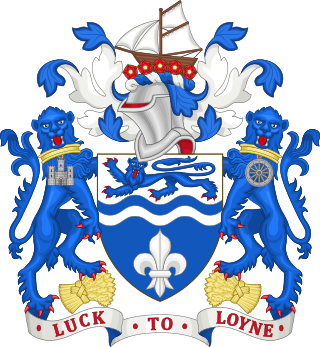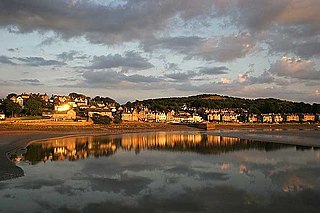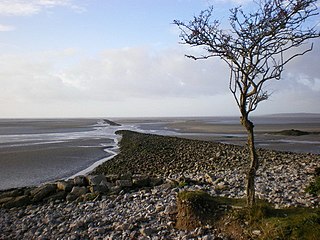
Jenny Brown's Point is a small headland in Silverdale parish, south of the village of Silverdale, in City of Lancaster district, Lancashire, England, on the edge of Morecambe Bay. [1]

Jenny Brown's Point is a small headland in Silverdale parish, south of the village of Silverdale, in City of Lancaster district, Lancashire, England, on the edge of Morecambe Bay. [1]
The point has also been known as Brown's Point (1812), Silverdale Point (1818) and Lindeth Point (1828); the name Jenny Brown Point was in use on an 1829 estate plan and was used by the Ordnance Survey from 1848. [2]
The identity of Jenny Brown is uncertain, though a daughter Jennet was born in 1628 to Robert Walling of Dikehouse, the farm at the point, and married Robert Brown (or Browen or Browne); one of their daughters was Jennet (born 1665), named Jennye in her father's will. It has been said that Jenny was a lover waiting for her lost sailor to return, a nanny who saved her charges from the tide, a lodging-house keeper, or a steam engine (or "jenny") sent to Brown's Point. [2]
A nearby chimney, sometimes described as a tower, is grade II listed [3] and has been the subject of archaeological and archival investigations. [4] [5] It is now believed that the chimney is most likely to be the remains of a short-lived copper mining and smelting project set up by Robert Gibson in the 1780s. He was Lord of the Manor of Yealand and incorrectly assumed he had the right to mine for copper at Cragfoot, inland from the point, on land owned by the Townleys of Leighton Hall. The copper was processed in a reverberatory furnace at Jenny Brown's Point of which the remaining chimney was part. The whole operation was abandoned in 1788 after lawsuits, and Gibson died in 1791. [6] [7]
Near the point there exists what is left of Walduck's Wall, an attempt to reclaim an area of land between the point and Carnforth: work began on the project in 1877 and ceased in 1879, and the stones were hidden under the bay's shifting sands for many years before re-emerging in 1975. [8] [9]

The 18th-century Brown's House or Brown's Houses at the point is grade II listed. [10]

In 1894, 25 people died when the Matchless sank off Jenny Brown's Point.

Lancaster is a city in Lancashire, England and the main cultural hub, economic and commercial centre of City of Lancaster district. The city is on the River Lune and directly inland from Morecambe Bay. Lancaster was the county town of Lancashire until the county council's administrative headquarters moved to Preston in 1974. The city's long history is marked by Lancaster Roman Fort, Lancaster Castle, Lancaster Priory Church, Lancaster Cathedral and the Ashton Memorial. It is the seat of Lancaster University and has a campus of the University of Cumbria. It had a population of 52,234 in the 2011 census compared to the district which had a population of 138,375. The city is an economic hub for the surrounding districts of Ribble Valley and Wyre as well as the Westmorland and Furness unitary area of Cumbria.

Leighton Moss RSPB reserve is a nature reserve in Lancashire, England, which has been in the care of the Royal Society for the Protection of Birds since 1964. It is situated near Silverdale, Carnforth, on the edge of Morecambe Bay and in the Arnside and Silverdale Area of Outstanding Natural Beauty.

Morecambe Bay is a large estuary in northwest England, just to the south of the Lake District National Park. It is the largest expanse of intertidal mudflats and sand in the United Kingdom, covering a total area of 120 sq mi (310 km2). In 1974, the second largest gas field in the UK was discovered 25 mi (40 km) west of Blackpool, with original reserves of over 7 trillion cubic feet (tcf). At its peak, 15% of Britain's gas supply came from the bay but production is now in decline. It is also one of the homes of the high brown fritillary butterfly.

Carnforth is a market town and civil parish in the City of Lancaster in Lancashire, England, situated at the north-east end of Morecambe Bay. The parish of Carnforth had a population of 5,560 in the 2011 census, an increase from the 5,350 recorded in the 2001 census. The town is situated around 7 miles north of Lancaster, 17 miles south of Kendal, 40 miles east of Barrow-in-Furness and 28 miles northwest of Settle. The town is also close to the Cumbria/Lancashire border.

Lancaster, commonly known as the City of Lancaster, is a non-metropolitan district within Lancashire, England, with the status of a city. It is named after its largest settlement, Lancaster, but covers a far larger area which includes the towns of Morecambe, Heysham, and Carnforth and a wider rural hinterland. The district has a population of 142,934 (2021), and an area of 222.5 square miles (576.2 km2).

There has long been debate over the exact location of the geographical centre of the United Kingdom, and its constituent countries, due to the complexity and method of the calculation, such as whether to include offshore islands, and the fact that erosion will cause the position to change over time. There are two main methods of calculating this "centre": either as the centroid of the two-dimensional shape made by the country, or as the point farthest from the boundary of the country. These two methods give quite different answers.

Arnside is a village and civil parish in Cumbria, historically part of Westmorland, near the border with Lancashire, England. The Lake District National Park is located a few miles north. Travelling by road, Arnside is 22 miles (35 km) to the south of Kendal, 25.3 miles (40.7 km) to the east of Ulverston, 35.2 miles (56.6 km) to the east of Barrow-in-Furness, 15.7 miles (25.3 km) to the west of Lancaster and 14.3 miles (23.0 km) to the east of Grange-over-Sands. In the 2001 census the parish had a population of 2,301, increasing at the 2011 census to 2,334.

Silverdale is a village and civil parish within the City of Lancaster district of Lancashire, England. The village stands on Morecambe Bay, near the border with Cumbria, 4.5 miles (7 km) north west of Carnforth and 8.5 miles (14 km) of Lancaster. The parish had a population of 1,519 recorded in the 2011 census.

Morecambe and Lunesdale is a constituency represented in the House of Commons of the UK Parliament since 2010 by David Morris, a Conservative.

Lancaster City Football Club is an English semi-professional non-League football club based in the northern city of Lancaster, Lancashire. They currently compete in the Northern Premier League Premier Division, the seventh tier of English football, and play at Giant Axe. They are full members of the Lancashire County Football Association.

Arnside and Silverdale is an Area of Outstanding Natural Beauty in England, on the border between Lancashire and Cumbria, adjoining Morecambe Bay. One of the smallest AONBs, it covers 29 square miles (75 km2) between the Kent Estuary, the River Keer and the A6 road. It was designated in 1972.

Warton is a village, civil parish and electoral ward in the City of Lancaster in north Lancashire in the north-west of England, close to the boundary with Cumbria, with a population of around 2,000, measured at the 2011 Census to be 2,360. It is a village steeped in history; its earliest recording as a settlement is made in Domesday Book written in 1086. The nearest town to Warton is Carnforth, which was originally part of Warton parish. It has connections to the first President of the United States, George Washington: Washington's ancestor of seven generations, Lawrence Washington, is rumoured to have helped build the village church of St Oswald. The parish covers an area in excess of 11,000 acres (45 km2) and is predominantly rural. The parish of Warton had a population of 2,315 recorded in the 2001 census, and 2,360 in the 2011 census.

Morecambe is a seaside town and civil parish in the City of Lancaster district in Lancashire, England. It is located in Morecambe Bay on the Irish Sea.

The trials of the Pendle witches in 1612 are among the most famous witch trials in English history, and some of the best recorded of the 17th century. The twelve accused lived in the area surrounding Pendle Hill in Lancashire, and were charged with the murders of ten people by the use of witchcraft. All but two were tried at Lancaster Assizes on 18–19 August 1612, along with the Samlesbury witches and others, in a series of trials that have become known as the Lancashire witch trials. One was tried at York Assizes on 27 July 1612, and another died in prison. Of the eleven who went to trial – nine women and two men – ten were found guilty and executed by hanging; one was found not guilty.

Warton Crag is a limestone hill in north west Lancashire, England. It lies to the north west of Warton village, in City of Lancaster district. At 163 metres (535 ft) it is the highest point in the Arnside and Silverdale Area of Outstanding Natural Beauty, and is listed as a "HuMP" or "Hundred Metre Prominence", having a "drop" or "prominence" of 126 metres (413 ft) with its parent being Hutton Roof Crags. Two areas are Local Nature Reserves, called Warton Crag and Warton Crag Quarry. Different sections are owned by Lancashire County Council, the Wildlife Trust for Lancashire, Manchester and North Merseyside, Lancaster City Council and the Royal Society for the Protection of Birds.

Holy Trinity Church, Morecambe, or Morecambe Parish Church, is in Church Street, Morecambe, Lancashire, England. It is the Anglican parish church of Morecambe, in the deanery of Lancaster, the archdeaconry of Lancaster and the diocese of Blackburn. The church is recorded in the National Heritage List for England as a designated Grade II listed building.

Hazelwood Hall, sometimes spelt Hazlewood, is a nineteenth-century country house set in 18.5 acres of woodland and gardens in the village of Silverdale, Lancashire, England, 8.5 miles (13.7 km) north of Lancaster. The building was converted into holiday flats in 2006.

The Matchless was a British pleasure yacht which sank in Morecambe Bay, off north west England, in 1894 with the loss of 25 lives.
Silverdale is a civil parish in Lancaster, Lancashire, England. It contains 20 buildings that are recorded in the National Heritage List for England as designated listed buildings. Of these, two are at Grade II*, the middle grade, and the others are at Grade II, the lowest grade. Most of the listed buildings in the parish are houses and associated structures, or farmhouses and farm buildings. The other listed buildings include a former chimney, a church, a public house, and a limekiln.

The Bay Cycle Way is an 80-mile (130 km) cycling route around Morecambe Bay in Lancashire and Cumbria in north west England. Most of it forms National Cycle Route 700, while other sections are waymarked as NCN 6, NCN 69 and NCN 70.
54°09′13″N2°49′41″W / 54.1537°N 2.8281°W